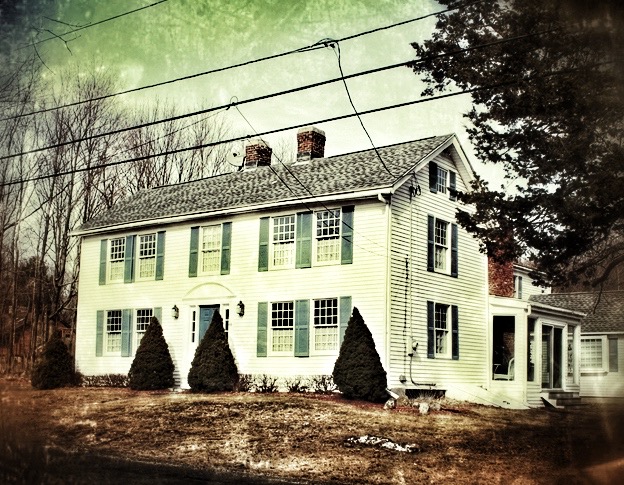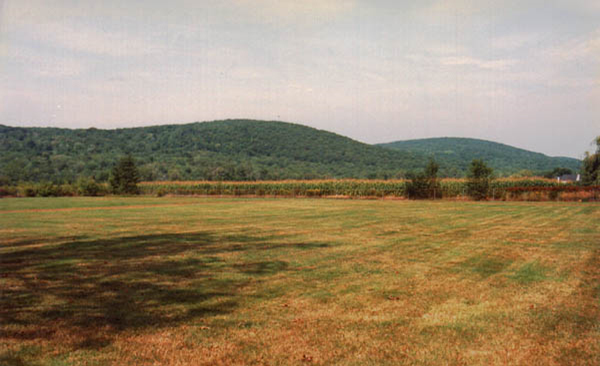
On a sparsely settled county street located in a Wilbraham, Massachusetts, a well-heeled bedroom community in the Western part of the state, there sits an attractive, Colonial-era home. Its handsome double chimney and freshly painted shutters are in keeping with its neighbors’ equally attractive and well-appointed homes. If you drove past it you would smile and think, “What a lovely old Colonial…I wonder what stories it would tell?” Well, as it would happen, this residence, referred to as the Randolph Beebe House, was the inspiration for a story. A rather remarkable story. In fact, this house built in 1785, was the inspiration for probably one of the most horrifying stories in American literature, “The Dunwich Horror”, by H.P. Lovecraft.
This horror classic, published in 1928, recounts the nefarious attempt by an eccentric local family, the Whately’s, to bring forth the end of the world by invoking an entity from another plane of existence. With the aid of ancient, obscure texts, the patriarch, “ancient, half-insane,” Old Whately conjures a force from another realm which his daughter, Lavinia, gives birth to on February 2nd. This date was not chosen at random. It is not only an ironic reference to Groundhog Day (instead of the promise of spring, this creature promises an eternal winter) but also a mockery of the Feast of Candlemas, the celebration of Jesus’ presentation at the Temple. The Whately’s scheme, however, is thwarted by a trio of academics who destroy the creature. Armed with their own resources of arcane knowledge as well as magic powders, the three gentleman slay the creature just as it is about to articulate its first words in English,”….Help! Help! Father! Father!”
It was the summer of 1928 and the writer H.P. Lovecraft was touring parts of New England. Primarily recognized as the 20th century’s most influential writer of supernatural fiction, Howard Phillips Lovecraft was also a Man of Letters. He wrote not only fiction but also poetry, literary criticism, journalism and travel writing. Contrary to popular belief, Lovecraft was not a recluse but traveled extensively and was gathering details for his latest travelogue, Observations on Several Parts of America, when he happened upon this house on Beebe Road.
However, unlike its current pristine condition, when Lovecraft drove past the Beebe house, it had been abandoned for about 5 years. The Randolph Beebe house’s mournful condition gave the writer his initial inspiration. According to a letter written by Lovecraft in 1934, “I saw the ruinous, deserted old Randolph Beebe house where the whippoorwills cluster abnormally…”
The writer was staying with a relative of Randolph’s, Evanore Beebe, who lived just a few miles away on Monson Road. It was later that year that he wrote “The Dunwich Horror,” inspired not only by the ravaged appearance of the decaying homestead but by several obscure New England legends that added to the atmosphere of the story. In his collection of travel essays, Observations on Several Parts of America (1928, Hippocampus Press), he wrote: “’The Dunwich Horror’ is based on several New England legends, one of which I heard for the first time during my sojourn in Wilbraham.”
One of those legends was the myth of the whippoorwill, which intrigued Lovecraft. Evanore informed him that a whippoorwill is an omen of death, a psychopomp, that captures the departed’ s soul and brings it to its just reward-whichever direction that might be. An innocuous looking bird, the whippoorwill is a plump, medium-sized bird. Its feathers are a mottling of brown, black, grey, and white which enables it to perfectly blend into the nighttime forests. Folk tales about the whippoorwill as a source of doom and despair go back to the Greeks as well as the ancestors of English settlers and the Native American people that had lived in the area of Lovecraft’s hosts. This relative of the nightjar has inspired countless writers and poet including Elizabeth Barret Browning, William Faulkner, and even more contemporary sources such as Hank Williams, J.J. Cale, and even Alan Jackson!
Mr. Lovecraft found Evanore an invaluable resource of information not only regarding the obscure local lore but also with becoming familiar with the town’s unique topography. The author found Wilbraham’s unique countryside delightful and intriguing enough to incorporate into his story. Of course, for the dramatic purposes of fiction, he did take some poetic license. For example, he wrote of the town’s natural beauty: “Wilbraham is a very lovely country—in the rich, gentle way of Massachusetts as opposed to the bold, dramatick quality of Vermont scenery. The vegetation is thicker and greener; and the hills, tho’ high and numerous, are more widely spread… I visited all the churchyards and burying places, and inspected the pleasing village of Wilbraham proper, where still flourishes the old academy founded in 1825.”

The gentle, unusually rounded hills of Wilbraham particularly fascinated him. The mountain range was once part of a shallow inland sea millions of years ago. But now, they were worn down and rounded to gentle slopes, more hill than their geographical assignation would denote. In the “The Dunwich Horror,” these characteristics take on a more sinister context, adding to the feeling of claustrophobic dread that envelopes the reader: “When a rise in the road brings the mountains in view above the deep woods, the feeling of strange uneasiness is increased. The summits are too rounded and symmetrical to give a sense of comfort and naturalness, and sometimes the sky silhouettes with especial clearness the queer circles of tall stone pillars with which most of them are crowned.”
Take Monson Road as it winds through the gentle Wilbraham Mountains to Beebe Road and you can witness how much and how little some things have changed in this small town in Western Massachusetts. Today, just in Lovecraft’s time, as you drive down Wilbraham’s Main Street you can see quaint locally-owned shops, beautiful Victorians houses, and gracious Colonial homes. Instead of carriages and wagons as in Lovecraft’s era, parents of the Wilbraham-Monson Academy students pick up their children in Escalades and Navigators.
The Beebe house is now a happily occupied home, there are more houses to wend by, traffic is more frequent as it is a bedroom community for Springfield, Boston, and Hartford workers. But still at night, especially when low clouds descend and cover the still tree covered hills, another-worldly feeling can be felt. The hills and the trees seem to close in as you drive through the low hanging clouds. Even while driving during a warm starry night you can anticipate the next curve or sharp dip in the road could bring you to one of those in-between spaces that Lovecraft was so apt in exploring.
Although the increased popularity of Lovecraft has brought some attention to the Beebe house, people in this town faithfully demonstrate that Yankee reserve which we New Englanders are known for. Occasionally, a local publication will publish an item about Lovecraft’s visit and the Beebe house-of course, right around Halloween. And of course, there is the subsequent tourist traffic, perhaps a half a dozen cars might slow down and take a few pictures. But then time passes, and the Thanksgiving and Christmas decorations go up and the tourists go away. As legendary houses go, its condition is not static. The Whaley and the Winchester Houses are permanently fixed in their pasts, the Amityville House is still a beacon due to a lurid history that is indelible. But the Beebe House is also a home. Whatever it meant to Lovecraft was based upon its former condition. There are no ghosts, no scandalous actions to make people still whisper about. The Beebe House is a legend because it was in the worse state at the right time. So perhaps what is the most astonishing thing about the house is that life went on just like in the story. Destruction and chaos gave way to growth and stability. Today, if you drive by the house, you need to close your eyes to see the falling shutters, visualize the destructive force emanating from the ruined porch. Maybe if you listen very closely, you can hear the faint cry of the whippoorwill. However, don’t be too startled if the slam of the screen door, the comforting glow of a porch light, or the sound of passing traffic pulls you back into the present. What becomes this New England legend the most? Well, in this case, it is history and just a little bit of the imagination.

Watched your TV show for the first time and I love it!!!! I’m very intrigued by the obscure and history of places around me. Thanks for introducing me to new adventures in my New England area.
Debbie Armstrong
Enfield, CT
I currently occupy and own the Beebe house! I enjoyed reading your article. I love being part of such a cool piece of history. And yes, we definitely do get people slowing down to take photos once in a while still